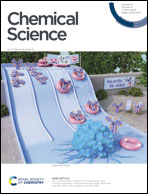Site-specific covalent metalation of DNA oligonucleotides with phosphorescent platinum(ii) complexes†
Abstract
Phosphorescent Pt(II) complexes, composed of a tridentate N^N^C donor ligand and a monodentate ancillary ligand, were covalently attached to DNA oligonucleotides. Three modes of attachment were investigated: positioning the tridentate ligand as an artificial nucleobase via a 2′-deoxyribose or a propane-1,2-diol moiety and orienting it towards the major groove by appending it to a uridine C5 position. The photophysical properties of the complexes depend on the mode of attachment and on the identity of the monodentate ligand (iodido vs. cyanido ligand). Significant duplex stabilization was observed for all cyanido complexes when they are attached to the DNA backbone. The luminescence strongly depends on whether a single or two adjacent complexes are introduced, with the latter showing an additional emission band indicative of excimer formation. The doubly platinated oligonucleotides could be useful as ratiometric or lifetime-based oxygen sensors, as the green photoluminescence intensities and average lifetimes of the monomeric species are drastically boosted upon deoxygenation, whereas the red-shifted excimer phosphorescence is nearly insensitive to the presence of triplet dioxygen in solution.



 Please wait while we load your content...
Please wait while we load your content...